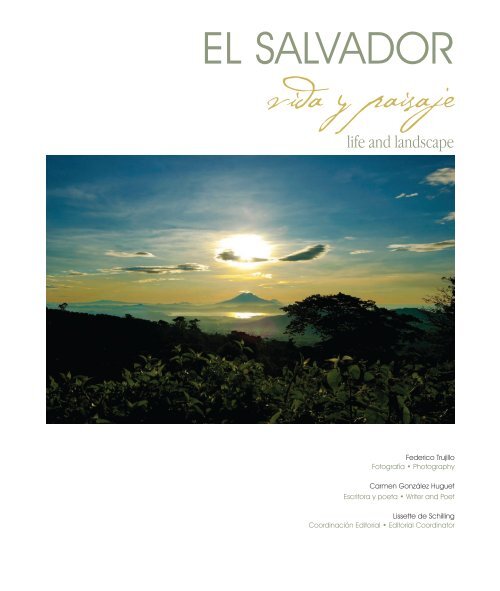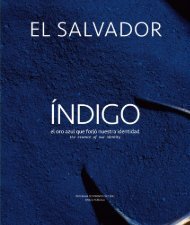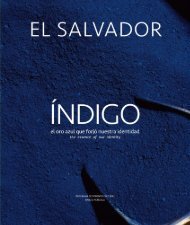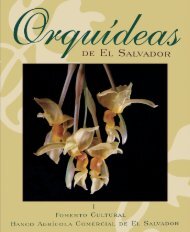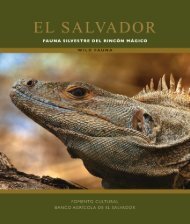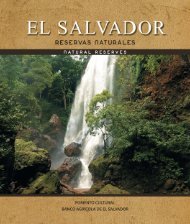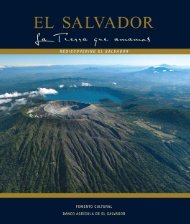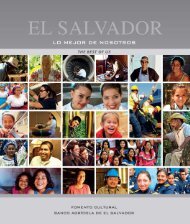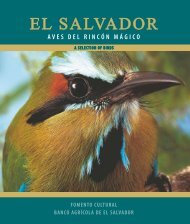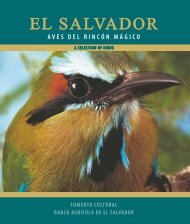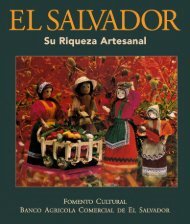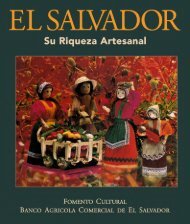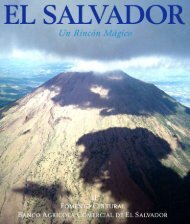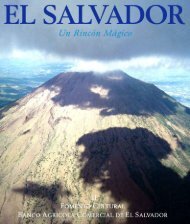Vida y Paisaje
Create successful ePaper yourself
Turn your PDF publications into a flip-book with our unique Google optimized e-Paper software.
EL SALVADOR<br />
vida y paisaje<br />
life and landscape<br />
Federico Trujillo<br />
Fotografía • Photography<br />
Carmen González Huguet<br />
Escritora y poeta • Writer and Poet<br />
Lissette de Schilling<br />
Coordinación Editorial • Editorial Coordinator
Cerro El Pilón y Volcán Ilamatepec, zona occidental.
econocimientos<br />
acknowledgements<br />
Jaime Velásquez<br />
Presidente Junta Directiva<br />
President Board of Directors<br />
Rafael Barraza<br />
Presidente Ejecutivo<br />
Executive President<br />
Coordinador general - General coordination<br />
Cecilia Gallardo<br />
Joaquín Rivas<br />
Coordinación editorial - Editorial coordination<br />
Lissette de Schilling<br />
Escritora - Writer<br />
Carmen González - Huguet<br />
Fotografía - Photography<br />
Federico Trujillo<br />
Asistente de fotografía - Photography asistant<br />
Nelson Crisóstomo<br />
Diseño Gráfico - Diagramación<br />
Graphic design, layout<br />
Eduardo Herrera<br />
Visión Corporativa<br />
704.943 697 284<br />
E49 El Salvador: vida y paisaje : Life and landscape / coordinación<br />
general Cecilia Gallardo; coordinación editorial Lissette de<br />
sv Schilling; escritora Carmen González Hugüet; fotografía<br />
Federico Trujillo; Traductor Anna Lucía Canessa. -- 1 a ed. --<br />
San Salvador, El Salv.: Banco Agrícola, 2015.<br />
156 p.: principalmente il. ; 34x29 cm.<br />
ISBN 978-99961-955-0-1 ( tapa dura )<br />
Traducción - Translation<br />
Anna Lucía Canessa<br />
Supervisión de producción digital y proceso de impresión<br />
Digital production and printing process supervision<br />
Lissette de Schilling<br />
BINA/jmh<br />
1. <strong>Paisaje</strong>s-El Salvador. 2. Naturaleza en el arte-El Salvador.<br />
3. Turismo-El Salvador. 4. Monumentos hitóricos-El Salvador.<br />
I. González Hugüet, Carmen, texto. II. Trujillo, Federico, fot.<br />
III. Banco Agrícola de El Salvador, ed. IV. Título.<br />
Impresión - Printing<br />
Artes Gráficas Publicitarias, S. A. de C. V.<br />
Empastado - Binding<br />
Librería y Papelería La Ibérica, S. A. de C. V.<br />
Banco Agrícola agradece el valioso apoyo para la realización<br />
de esta edición a Dr. Maximiliano A. Martínez y Enrique Fuentes.<br />
© 2015. Banco Agrícola. Derechos reservados.<br />
Queda prohibida, como lo establece la ley, la reproducción parcial o total de este<br />
libro sin previo permiso por escrito del editor, con excepción de breves fragmentos<br />
que pueden usarse en reseñas en los distintos medios de comunicación, siempre que<br />
se cite la fuente.
Laguna de Alegría, departamento de Usulután.
Vista de San Salvador.
Cerro Verde y volcán Ilamatepec.
contenido<br />
content<br />
caminando por los cerros<br />
walking the hills<br />
22<br />
bajo la sombra de los volcanes<br />
beneath the volcano-s shadow<br />
50<br />
los rostros cambiantes de las aguas<br />
the faces of waters<br />
84<br />
verdes eternos<br />
eternal green<br />
136
San Idelfonso, departamento de San Vicente.
presentación<br />
La breve extensión del territorio de nuestro país guarda la obra de la naturaleza que se despliega en<br />
sitios de extraordinaria hermosura. Esto es motivo para realizar una nueva edición de la colección<br />
El Salvador, un Rincón Mágico. Un conjunto de paisajes soñados se despliega a través de estas<br />
páginas, que son parte de una serie cuya producción lleva más de dos décadas deslumbrándonos<br />
con su encanto y colorido, al entregar al mundo la riqueza de nuestro terruño.<br />
Banco Agrícola se enorgullece en presentar, a través de su Programa de Fomento Cultural, otro<br />
volumen que exalta y comparte el honor de haber nacido en esta tierra tan generosa y fecunda, tierra<br />
que ha permitido que nuestra gente cultive las peculiaridades de nuestra idiosincrasia, así como su<br />
proverbial laboriosidad.<br />
La imponencia de nuestros volcanes y cordilleras, las bellas planicies y los innumerables nacimientos<br />
de agua: todos han contribuido a dibujar el perfil de nuestro territorio, donde los accidentes naturales<br />
se conjugan con los asentamientos humanos y crean una diversidad de paisajes en la que conviven<br />
la flora, la fauna y la tierra labrada por la voluntad de salir adelante y la esperanza de un futuro<br />
promisorio.<br />
Este paisaje irrepetible e irreemplazable es un regalo a nuestros sentidos. A través de estas páginas<br />
queremos reconocer este suelo, y hacer conciencia a nuestros conciudadanos de la importancia de<br />
amarlo y de cuidarlo para que los hijos de nuestros hijos hereden este Rincón Mágico.<br />
Flor y semilla, tallo y profunda raigambre, copa florida y corteza arrugada, de nuestra tierra crecen<br />
los árboles a cuya sombra un pueblo teje, incesantemente, la vida, y se asoma al futuro. Que al<br />
recorrer estas páginas, podamos decir como el poeta Hugo Lindo:<br />
“Yo soy de este lugar. Le pertenezco…<br />
Toda su orografía es mi sustancia.<br />
Sus ríos cruzan, tibios, por mis venas,<br />
y el aire que lo arropa es el mismo aire<br />
que en la voz se hace sílaba o poema…”<br />
Sirva este libro para recordarnos lo que nunca debemos olvidar: somos de aquí, y a esta tierra que<br />
ha de cubrirnos los párpados un día, siempre debemos volver. Porque es nuestra. Y porque todos y<br />
cada uno somos suyos.<br />
12
Río Sapo, Municipio de Arambala, departamento de Morazán.
Río Grande, departamento de San Miguel.
foreword<br />
The brief extension of our territory keeps the creation of a nature which unfolds itself into<br />
extraordinary, beautiful sites. This represents an excellent opportunity to bring up a new<br />
edition to El Salvador’s Collection; “Rincón Mágico”. A set of dreamed landscapes displays<br />
throughout these pages; which forms a part of a set whose production carries more than<br />
two decades dazzling us with its charm and color, when giving to the world the richness of<br />
our homeland.<br />
Banco Agricola feels proud to present; through its Cultural Promotion Program, another<br />
volume which exalts and shares the honor to have been born in this so generous and fertile<br />
land; a land which has allowed our people to grow the singularities of our idiosyncracy, as<br />
well as its proverbial industriousness.<br />
Our volcano’s and range´s impressiveness, the beautiful plains, and numberless water<br />
sources; all of them have contributed to draw the expression of our territory. We are able to<br />
see where natural, accidental landscapes combine along with human settlements and create<br />
a diversity of settings; in which it is expressed and carved on earth, the will of men to go on<br />
and coexist with its vegetation and wildlife, for the hope of a promising future.<br />
This unrepeatable and irreplaceable landscape is a gift to our senses. Throughout these<br />
pages, we want to recognize the land, and give conscience to our fellow citizens about<br />
the importance of loving and taking care of it, so that the children of our sons inherit<br />
El Salvador´s “Rincón Mágico”.<br />
Flower and seed, stem and deep traditions, blooming treetop and wrinkled crust; people<br />
weave beneath the shadow of trees that grow from our soil, and constantly, into life, as<br />
future approaches. As we read forward, we hope to quote what Poet Hugo Lindo said:<br />
“I am from this place. I belong to it…<br />
All its orography is my substance.<br />
Its rivers cross, warm, through my veins,<br />
And the air which covers it, is the same air<br />
That in the voice becomes a syllable or poem…”<br />
We hope this book helps to remember what we should never forget: we are from here, and<br />
to this land which will cover our eyes one day, we will return; because it is ours and because<br />
all and each one of us belongs to her.<br />
15
Tormenta nocturna sobre cordillera El Bálsamo.
Vista del volcán de San Miguel desde la Zona Norte.
introducción<br />
Si fuéramos pájaros y pudiéramos volar sobre el territorio de nuestro país, tal vez nos<br />
sorprendería grandemente advertir lo variado que es el relieve en estos escasos veintiún<br />
mil kilómetros cuadrados: al sur, el enorme Océano Pacífico, el más extenso del mundo,<br />
bate interminable, bañando con sus mareas nuestras costas. A veces la orilla azul del<br />
océano orlada de blanca espuma se estrella contra los altos farallones de roca. Otras,<br />
besa con dulzura las playas de arena gris.<br />
Esta cinta de costa corre a lo largo de 321 kilómetros, desde el río Paz hasta el golfo de<br />
Fonseca, interrumpida solo a la altura de la playa de Los Cóbanos por la arena blanca<br />
de su arrecife de coral.<br />
Apenas unas decenas de kilómetros más al norte, el paisaje asciende por un lento<br />
declive hasta las airosas cumbres de un horizonte poblado de volcanes. Varias cadenas<br />
montañosas atraviesan nuestro país de este a oeste, como parte del “Cinturón de Fuego<br />
del Pacífico”: un rosario de fallas tectónicas y cráteres que delinean el paisaje desde<br />
Tierra del Fuego hasta Alaska, y que forman la columna vertebral de nuestro continente<br />
americano.<br />
Desde las costas que bañan las heladas aguas del mar de Bering, el cinturón continúa<br />
hacia el oeste, a lo largo de la geografía de Japón, modelada a golpe de erupciones<br />
y de fatídicos terremotos, lo mismo que en las islas Hawái, Taiwán, Filipinas, Nueva<br />
Guinea y las lejanas tierras de Nueva Zelanda.<br />
El paisaje salvadoreño sube desde el mar hasta las cumbres de Chalatenango y<br />
Morazán. Esta región, en otra época tan aislada, es ahora conectada por la Carretera<br />
Longitudinal del Norte, que va desde la ciudad de Metapán, en el departamento<br />
de Santa Ana, hasta el municipio de Concepción de Oriente, en La Unión.<br />
El Salvador, en alusión a su verdadero nombre indígena, Cuscatlán, es un pequeño<br />
joyel que encierra en su breve extensión un tesoro de maravillosos paisajes soñados,<br />
encanto y colorido que cautivan nuestro corazón.<br />
Esta tierra alimenta las raíces de los millones de hombres y mujeres que desde tiempos<br />
ancestrales en ella se han asentado y han construido su existencia. Aquí nacieron,<br />
y aunque la distancia a veces los aleja, siempre regresan en carne o pensamiento.<br />
Esta tierra es la madre que nunca olvida a sus hijos y que los alimenta con inagotable<br />
generosidad. Deleite para el espíritu en la belleza de sus rincones y dulzura que surge<br />
pródiga de los surcos.<br />
19
introductión<br />
If we were birds, and could fly the territory of our country, we would be highly impressed<br />
about how much we would have to warn about the diversity found in the landscapes in<br />
these few twenty one thousand square kilometers. At the south, it joins the Pacific Ocean:<br />
the most extense one, bathing our coasts with endlessly shifting ties. Sometimes, the blue<br />
shores of the ocean covered with white foam clash against the high steef rock. In others,<br />
the sea touches with sweetness the beaches of gray sand.<br />
This belt runs 321 kilometers along the coast; from Rio Paz up to Golfo de Fonseca.<br />
However, Los Cobanos does make an interruption because of it’s white sand from the<br />
coral reef.<br />
Just a few dozens of kilometers to the north, the landscape begins to rise through a<br />
slow slope all the way up to a horizontal airy summit; populated by volcanoes. Several<br />
mountain ranges cross the nation from east to west, which line up to the “Ring of Fire”:<br />
a rosary of tectonic faults and craters which form up the scenery starting from Tierra del<br />
Fuego up to Alaska, and they make up the vertebral column of our American Continent.<br />
The belt continues moreover to the west. It stretches, touching the coasts with cold waters<br />
from the Bering Sea, running all the way as far as reaching Japan’s geography; composed<br />
by eruptions and fatal earthquakes, just like in Hawaii, Taiwan, The Philippines, New<br />
Guinea, and the far away lands of New Zeland.<br />
The Salvadorean landscape begins its elevation from seashore; meeting the summit<br />
at Chalatenango and Morazan. This region, isolated at some point in time, is now<br />
connected by the Northern Highway, which goes from the City of Metapan, in Province<br />
of Santa Ana, to the town of Concepcion de Oriente, located at La Union.<br />
A paradise in the palm of a hand; El Salvador is a small jewel which encloses dreamed<br />
landscapes in a brief extension, full of charm and color, captivates our hearts.<br />
This earth feeds the heritage of millions of men and women who have settled since<br />
ancient times on it and have built up their existence. It was here that they were born; and<br />
even if the distance tears them apart, they always come back in the flesh or spirit. This<br />
is the earth that never forgets its children and inexhaustible feeds them with abundance<br />
of generosity. Its spectacular angles and corners become delightful to the soul; and<br />
sweetness arises lavishling from the groove.<br />
20
Laguna Bruja, departamento de San Vicente.
caminando por los cerros<br />
walking the hills
24<br />
Caminata al cráter del volcán Ilamatepec, departamento de Santa Ana.
Desde la noche de los tiempos,<br />
millares de pasos han recorrido nuestro terruño<br />
de norte a sur y de este a oeste;<br />
no hay en El Salvador horizonte<br />
que esté demasiado lejano.<br />
Todo está ahí, “detrás de aquellos cerros”,<br />
hasta el mar esconde su secreto<br />
tras una fila de montañas azules.<br />
Vinieron caminando desde el norte lejano,<br />
donde una profecía les ordenó<br />
buscar una tierra de tesoros.<br />
Aquellos cazadores se aposentaron junto al fuego,<br />
y en el amanecer de una nueva jornada,<br />
iniciaron la siembra.<br />
Así, los errabundos nómadas<br />
se convertieron en agricultores.<br />
Sus manos laboriosas acariciaron el barro,<br />
tejieron redes, alzaron piedras<br />
para el culto divino y, consagraron con su trabajo<br />
y su fervor, la tierra<br />
para sustento de los suyos.<br />
Y después, nuevos hombres cruzaron el mar,<br />
y vestidos de hierro, conquistaron esta comarca,<br />
mezclando su sangre con la de los antiguos ancestros.<br />
Una nueva estirpe surgió de aquel choque violento,<br />
y sus hijos levantaron ciudades y torres con campanas<br />
que cantaban en una lengua nueva.<br />
Llegó después la hora de inaugurar la libertad.<br />
Y nuevos símbolos se alzaron<br />
para dibujar la faz de la nación.<br />
Así entramos a un nuevo mundo,<br />
donde la antigua paz del sembrador<br />
por momentos se olvida.<br />
Pero la tierra siente,<br />
tan próxima a los pasos que cruzan,<br />
incesantes, por todos los senderos, y sigue,<br />
como antes, brindándonos el fruto de su entraña.<br />
Esta tierra que a todos nos cobija y que,<br />
desde el abismo del tiempo,<br />
custodia para nosotros una herencia preciosa.<br />
Since the dawn of times,<br />
millions of steps have travelled our land<br />
from North to South and East to West;<br />
there is no horizon in El Salvador too far away.<br />
Everything is there,<br />
“behind those hills”,<br />
even the sea hides its secret<br />
behind a chain of blue mountains.<br />
They came walking from the distant north,<br />
where a prophecy commanded<br />
to seek a land of treasures.<br />
Those hunters settled next to the fire,<br />
and at the dawn of a new working day,<br />
started to plant.<br />
That is how the wandering nomads<br />
became farmers.<br />
Their laborious hands caressed the clay,<br />
weaved nets, raised stones<br />
for the divine worship, and sanctify; with their work<br />
and their passion, the land<br />
for the livelihood of their own.<br />
Moreover, new men crossed the ocean,<br />
and covered up with iron, conquered this region,<br />
mixing their blood with the one of the old ancestors.<br />
A new race emerged from this violent clash,<br />
and their children raised buildings and towers with bells<br />
which would sing in a new language.<br />
Time to open up to liberty came.<br />
New symbols arose<br />
to draw the face of the nation.<br />
This is how we became into a new world,<br />
where the antique peace of the sower<br />
is forgotten from time to time.<br />
But the land feels,<br />
so close to the steps that get crossed,<br />
ceaseless, through all the paths, and continues,<br />
like before, providing the fruit of her womb.<br />
This land which warms us up and that,<br />
since the abyss of time,<br />
guards a precious inheritance for all of us.<br />
25
26<br />
Volcán Chinchontepec, departamento de San Vicente.
Parque Los Volcanes.<br />
Zona occidental, al fondo volcán El Chingo.<br />
27
Imagen de la mujer dormida en el Cerro de Guazapa.
Complejo Los Volcanes.<br />
Flores de la zona.
Cerro El Pital, departamento de Chalatenango.
Caminata en el volcán Quezaltepec, San Salvador.
Boquerón, departamento de San Salvador.<br />
El espíritu renueva su energía entre valles y montañas.<br />
The spirit renews its energies in the midst of valleys and mountains.<br />
33
Volcán de Izalco, departamento de Sonsonate.
Ciclistas en la Laguna Verde, Apaneca.<br />
Caminata en Volcán Ilamatepec, Santa Ana.
Panorámica del Peñón de Comasagua, La Libertad.
Cadena montañosa, departamento de Morazán.
El Pital, departamento de Chalatenango.
Perquín, departamento de Morazán.
Las Pilas, departamento de Chalatenango.<br />
Patria, en tu pequeña geografía<br />
cabe toda la luz, la gama de los verdes,<br />
el arrullo del ave.<br />
40
Montecristo, Metapán, departamento de Santa Ana.<br />
Homeland, in your small geography<br />
embraces all light, shades of green,<br />
the sing of birds.<br />
41
Zona cafetalera Comasagua, departamento de La Libertad.
Beneficio de café, Juayúa, departamento de Sonsonate.<br />
De tu vientre, tierra fecunda,<br />
y del esfuerzo de tus hijos,<br />
nacen la riqueza y el sustento.<br />
From your womb; fruitful land,<br />
and from the effort of your children,<br />
richness and livelihood are born.<br />
43
Valle de Jiboa, departamento de San Vicente.
46<br />
Cerro Guaycume, Apopa, departamento de San Salvador.
Vista del Picacho desde Apopa, departamento de San Salvador.<br />
47
Volcán Ilamatepec, Izalco, Cerro Verde y Lago de Coatepeque.
ajo la sombra de los volcanes<br />
beneath the volcano ’ s shadow
Vista de San Salvador.
Pequeña patria, tu verdor florece<br />
entre montañas rudas y magníficas,<br />
valles donde la vida se remansa,<br />
cielos que en el ocaso se desangran<br />
y, heridos, caen al mar, que en su mutismo,<br />
guarda tesoros viejos y naufragios.<br />
Tierra, tu orografía se despliega<br />
en aristas y vórtices profundos,<br />
y coronan tus anchos horizontes<br />
una extensión de cráteres azules.<br />
Cincelada por grandes terremotos,<br />
violentas erupciones,<br />
golpes de lava ardiente, vendavales,<br />
la tierra fue ensanchando sus colinas,<br />
mientras el agua dibujó hondonadas,<br />
quietas cavernas, silenciosas grutas,<br />
floridos llanos y paisajes dulces<br />
donde el viajero del afán reposa.<br />
Al norte la escarpada cordillera<br />
de Alotepeque-Metapán custodia<br />
las torres ancestrales de la iglesia<br />
de San Pedro y sus gráciles campanas.<br />
Al sur, como un dragón, desde Tacuba,<br />
la sierra repta entre cafetos, bosques,<br />
piedras abuelas, pueblecitos plácidos,<br />
en una fila de dormidas cumbres.<br />
En ella brillan, verdes, Apaneca,<br />
Ataco, Los Naranjos y Juayúa,<br />
hasta el árido cráter de Santa Ana,<br />
montaña abuela a cuyos pies destaca,<br />
como una flor de ópalo, Coatepeque.<br />
Y más allá, los árboles de bálsamo<br />
pueblan la cordillera de Jayaque<br />
con su savia aromada y su corteza<br />
de perfumada esencia bienechora.<br />
Prolonga la alta sierra su osamenta<br />
de lava congelada<br />
y hacia la Mar del Sur se precipita<br />
en un oscuro litoral basáltico.<br />
Y después la apretada orografía<br />
remata sus alturas con la rúbrica<br />
volcánica y excelsa de Ilopango,<br />
donde turquesas límpidas y espumas<br />
tejen un nido de esmeraldas vivas.<br />
Al otro lado del profundo valle,<br />
donde la capital corona sus afanes,<br />
alzan sus cimas de verdor perenne<br />
el Boquerón, el Jabalí, el Picacho,<br />
que en la vigilia de la Patria cuidan<br />
a la ciudad de laborioso cauce.<br />
Y allá más lejos, sobre el lago alzada,<br />
la doble cumbre airosa señorea<br />
del valle de Jiboa su fecunda<br />
heredad de dulzuras, San Vicente.<br />
Y mucho más lejanos, casi blancos,<br />
al lado de Berlín y de Alegría,<br />
los picos de Tecapa Chinameca<br />
con su frente de luz tocan el cielo.<br />
Corazón que se sale de la tierra<br />
en su latir de pertinaz retumbo,<br />
Chaparrastique con su abierto cráter<br />
a la ciudad de San Miguel se asoma.<br />
Y más al norte, como en una ensarta<br />
de gemas vivas vibran Ciudad Barrios,<br />
Gualococti, Osicala, San Isidro,<br />
San Simón, Yoloaiquín, hasta Chilanga,<br />
pueblos dormidos a la verde sombra<br />
de los cafetos de su fértil huerta:<br />
sierra de Corobán-Cacahuatique.<br />
En Morazán, como la lenta escala<br />
del patriarca Jacob, se trepa al cielo<br />
la prolongada sierra de Arambala<br />
que cobija a Perquín y a San Fernando.<br />
Al centro, en las comarcas fronterizas,<br />
Chalatenango afina su estatura<br />
en El Pital, donde la nieve pone<br />
pétalos de blancura en cada hoja.<br />
Es esta mi heredad, mi geografía,<br />
que pueblan aves de sonoro trino.<br />
Pétrea flor, verticales catedrales,<br />
ángeles que custodian el silencio<br />
en alturas de vértigo y neblina:<br />
Volcanes, lava antigua que alimenta<br />
suelos feraces y profundos surcos.<br />
Guardianes que en la noche de los tiempos<br />
emergieron del mar,<br />
tejieron puentes entre recién nacidos continentes.<br />
Tutelares, callados: a su vera, florida,<br />
se establece la energía tenaz de las aldeas.<br />
Y aquí, junto a la luz de los volcanes,<br />
surge este pueblo terco y su linaje,<br />
que se aferra a la tierra<br />
en su apretado ramillete<br />
de sueños palpitantes.<br />
Este es mi pueblo, mi querencia humana.<br />
Estoy sembrada en su raíz oscura.<br />
Y habremos de surgir hacia la vida<br />
como surgen la flor y la semilla.<br />
53
Little homeland, your greenery blossom<br />
among rough and magnificent mountains,<br />
valleys in which life allays,<br />
heavens which bleed at sunset<br />
and, hurt, fall into the ocean, which in its muteness,<br />
keeps old treasures and shipwrecks.<br />
Land, your orography displays<br />
in edges and deep turbulent spirals,<br />
and your broad horizons crown<br />
an extension of blue craters.<br />
Carved by huge earthquakes<br />
and violent eruptions,<br />
slamed by hot molted lava, storms;<br />
the earth stretched its hills,<br />
while the waters drew hollows,<br />
still caverns,<br />
quiescent grottos,<br />
blooming flats, and sweet landscapes<br />
were the traveler rests from its eagerness.<br />
At the north, the rocky mountain range<br />
of Alotepeque-Metapan guards<br />
the ancestral towers of the Church<br />
of San Pedro and its graceful bells.<br />
To the south, just like a dragon, from Tacuba,<br />
the mountain chain creeps among coffee trees,<br />
forests,ancestral stones, calm little towns,<br />
in a line of sleeping summits. Apaneca,<br />
Ataco, Los Naranjos, and Juayua<br />
shine green<br />
up to the dry crater of Santa Ana,<br />
an elderly mountain. At its feet, Coatepeque highlights<br />
like an opal flower.<br />
And more over, balsam trees<br />
inhabit the mountain range of Jayaque<br />
with its sap smell and<br />
its perfumed essence of benevolent crust.<br />
The high range extends its skeleton<br />
of solid lava<br />
and heading to the south sea, rushes<br />
into a dark balsatic seacoast.<br />
And then the tight orography<br />
tops off its heights with the tall volcanic feature<br />
of Ilopango, where turquoise and foam<br />
weave a lively emerald nest.<br />
At the other side of the deep valley,<br />
the capital crowns its labors<br />
beneath the shadow of<br />
El Boqueron, El Jabali, El Picacho Volcanoes,<br />
in its evergreen.<br />
There, the homeland vigils<br />
a laborious city.<br />
And farther away, above the lake, rises<br />
the double summit that dominates gracefully<br />
from the Jiboa Valley, its fruitful<br />
sweet property, San Vicente.<br />
And stretching some more into the east, almost white,<br />
nearby Berlin and Alegria,<br />
the pinnacles of Tecapa-Chinameca<br />
touch the heavens with its forehead.<br />
El Chaparrastique,<br />
heart that arouses from the earth<br />
in its pertinacious, beating, boom,<br />
thrusts out from its open crater to the City of San Miguel.<br />
Onto the north, like a live stripe of gems,<br />
vibrate Ciudad Barrios,<br />
Gualococti, Osicala, San Isidro,<br />
San Simon, Yoloaiquin, up to Chilanga,<br />
sleepy villages onto the shadow<br />
of the coffee trees of its fruitful orchard:<br />
Mountain Range Coroban-Cacahatique.<br />
In Morazan, like the slow ladder<br />
of Patriarch Jacob, Arambalas Range<br />
climbs in a long form into the heavens<br />
covering Perquin and San Fernando.<br />
To the center, to the frontiers regions,<br />
Chalatenango tunes up its height<br />
in El Pital, where the snow puts<br />
white petals in each leaf.<br />
This is my inheritance, my geography,<br />
in which birdsongs inhabit.<br />
Petals of flowers, vertical cathedrals,<br />
angels keeping high, the silence<br />
of intense rhythm and mist:<br />
Volcanoes, ancient lava that feeds<br />
fertile and deep grooves.<br />
Guardians which emerged from the sea back in time,<br />
weaved bridges between newborn continents.<br />
Silent protectors, in its flowering edge,<br />
establish the energy of the tenacious villages.<br />
And here, at the light of the volcanoes,<br />
arises this stubborn people<br />
and its ancestry,<br />
which holds to its land in its tight<br />
bundle of throbbing dreams.<br />
This is my homeland, my human fondness.<br />
I am planted in its dark root.<br />
And we shall raise up onto life;<br />
just like a flower and a seed come up.
Santa Tecla, departamento de La Libertad.<br />
55
Santa Tecla, ciudad de las neblinas,<br />
entre verdes colinas reclinada.<br />
En sus antiguos muros se agitan<br />
campanas y palomas.<br />
Santa Tecla, departamento de La Libertad.<br />
In green hills, reclines the city of mist,<br />
Santa Tecla.<br />
Bells and doves<br />
dance in its antique walls.<br />
56
Cordillera del Bálsamo, Santa Tecla, departamento de La Libertad.
Cráter Volcán Quezaltepec, departamento de San Salvador.
Faldas del Cerro San Jacinto, departamento de San Salvador.<br />
59
Comasagua, departamento de La Libertad.<br />
Comasagua,<br />
mirador para asomarse<br />
a un cielo de cristal<br />
y a un horizonte poblado<br />
por montañas azules.<br />
Comasagua,<br />
a balcony to lean out into<br />
a crystal sky<br />
and a horizon inhabited<br />
by blue mountains.<br />
60
Altamira, departamento de San Salvador.
Panorámica zona sur, Gran San Salvador.
Los Chorros, Carretera Panamericana, departamento de La Libertad.<br />
Entre verdes montañas,<br />
añosos árboles meditan y se asoman<br />
al misterio del agua que nace entre las rocas.<br />
Between green mountains,<br />
long-lived trees muse and care to lean out<br />
to the misterious birth of waters that emerge among rocks.<br />
63
El Playón, entre Quezaltepeque y San Juan Opico,<br />
departamento de La Libertad.
Cojutepeque, departamento de Cuscatlán.<br />
El Sartén, Apopa, departamento de San Salvador.<br />
66
Apopa, departamento de San Salvador.
Cordillera al norte de Chalatenango.
Santiago de María, departamento de Usulután.
Santiago de María, departamento de Usulután.<br />
Aromada de cafetos en flor<br />
y custodiada por cumbres e izotes,<br />
Santiago de María amanece<br />
con la suave frescura del rocío.<br />
The smell of coffee trees in blossom<br />
and guarded by peaks and “izote”,<br />
Santiago de Maria awakens at the dawn of the dew.<br />
with the soft coolness from the dew.<br />
71
Berlín, departamento de Usulután.<br />
San Simón, departamento de Morazán.<br />
72
San Sebastián, departamento de San Vicente.
Cerro El Pilón, Cordillera de Apaneca.
Volcán de San Miguel desde la Bahía de Jiquilisco.
78<br />
Volcán de San Miguel.
Ciudad de San Miguel.<br />
79
San Bartolo, Los Núcleos, departamento de Chalatenango.<br />
Los hombres con sus blancas construcciones<br />
y un horizonte de montañas<br />
casi besan el cielo.<br />
Men with white constructions<br />
and a horizon of mountains<br />
almost kiss the sky.<br />
80
San Bartolo, los nucleos, departamento de Chalatenango.
Lago de Coatepeque, departamento de Santa Ana.
los rostros cambiantes de las aguas<br />
the faces of waters<br />
Cascada El Balsamar, San Julián, departamento de Sonsonate.
Como sangre que viaja por tus venas<br />
recorre el agua la extensión florida<br />
de tu cuerpo gentil, Patria querida,<br />
poblada de vergeles y colmenas.<br />
Coronada de rosa y azucenas<br />
en el fulgor del alba, bendecida<br />
por el rocío, surges a la vida<br />
con veneros de luz a manos llenas.<br />
Nube y espuma forman tus afluentes<br />
y riegan tu fecunda orografía<br />
y alimentan veneros y torrentes.<br />
En sus rostros cambiantes la porfía<br />
de las aguas se vierte entre tus fuentes<br />
y nutre sin cesar tu geografía.<br />
Tierra del corazón, en tus entrañas<br />
guardas los cauces de feraces ríos<br />
que riegan campesinos sembradíos,<br />
urbes pujantes, ínsulas extrañas.<br />
Va el agua dibujando las montañas,<br />
valles agrestes, árboles umbríos<br />
entre recodos claros, caseríos,<br />
aldeas quietas, plácidas cabañas.<br />
El agua se hace aire con la espuma,<br />
pone su impronta fiel en el paisaje,<br />
borra colores con pincel de bruma<br />
y, hecha rocío, escribe su lenguaje<br />
con la delicadeza de una pluma<br />
que, vuelta nube, brilla en el celaje.<br />
Waters run through the extense colors<br />
of your gentle body.<br />
Like blood traveling through its veins, dear homeland,<br />
you are inhabited by orchards and beehives.<br />
Crowned with roses and lilies<br />
in the spark of dawn, blessed<br />
by the dew, you arise into life<br />
with hands full of light beams.<br />
Clouds and foam shape up your tributaries<br />
and irrigate your fertile orography<br />
and feed springs and streams.<br />
In its different faces, the strive<br />
of the waters pours from its fountains<br />
and feeds your geography.<br />
Land of the heart, you keep in your womb<br />
the riverbeds of ferocious streams<br />
which irrigate the sowing of peasants,<br />
foreceful cities, distant islands.<br />
The water defines the mountains,<br />
wild valleys, shadowy trees<br />
among clear angles, hamlets,<br />
calm villages, peaceful cabins.<br />
The water makes itself air in the foam,<br />
faithful portraits the landscapes<br />
and erases color with mist brushes.<br />
And, spilling dew, writes its language<br />
with the feathers finesse,<br />
and torn into a cloud, shines all over the heavens.<br />
86
Cascada del Río Sapo, departamento de Morazán.
Río Torola, departamento de Morazán.
90<br />
Afluente en Bosque El Imposible, departamento de Ahuachapán.
Rio zona Santa Rosa Guachipilín, departamento de Santa Ana.
Cascada El Balsamar, San Julián, departamento de Sonsonate.
Río Caserío La Laguna, departamento de Chalatenango.<br />
Entre el follaje siempre verde,<br />
con paciencia infinita,<br />
las corrientes acarician la entraña de la piedra<br />
hasta vencerla.<br />
Among the foliage which is always green,<br />
with infinite patience,<br />
the currents pet the core of the stone<br />
until it overcomes.<br />
93
Río Sumpul, departamento de Chalatenango.
Cascada El Balsamar, San Julián, departamento de Sonsonate.<br />
Cansada de arrastrarse<br />
por su profundo cauce,<br />
la serpiente del agua quiere ser cabellera,<br />
lluvia menuda o perla de rocío,<br />
y salta hacia el abismo,<br />
vertical y flexible,<br />
con voluntad de acróbata.<br />
Tired of crawling<br />
in its deep channel,<br />
the water becomes a horses tail,<br />
little rain or dews pearl,<br />
and jumps into the abyss,<br />
vertically and flexible,<br />
like an acrobats talent.<br />
96
Cascada zona La Montañona, departamento de Chalatenango.
Cascada Montecristo, Metapán, departamento de Santa Ana.<br />
La poza ahonda<br />
el misterio del agua<br />
poblado de rumores y de espumas.<br />
The pond deepens<br />
the mystery of the water<br />
inhabited by rumors and foams.<br />
99
Unión de los ríos Lempa y Torola.<br />
Como las venas en el cuerpo joven<br />
de la tierra, los ríos<br />
trenzan su sangre cristalina.<br />
Like veins in the young body<br />
of the earth, the rivers<br />
weave its crystalline blood.<br />
101
102<br />
Río Lempa, departamento de Chalatenango.
Cultivo de tilapia, departamento de Chalatenango.<br />
103
Regadío Bajo Lempa, departamento de Usulután.
El Cajón, Río Lempa.<br />
Tierra del corazón,<br />
el río Lempa te recorre<br />
como una larga<br />
cabellera adornada de esmeraldas.<br />
Land of the heart,<br />
Lempa’s River runs<br />
like a long<br />
tail decorated with emeralds.<br />
106
Caserío, Río Lempa.
108<br />
Lago de Suchitlán, departamento de Cuscatlán.
Embalse de Presa 5 de Noviembre, departamento de Chalatenango.<br />
109
Presa hidroeléctrica 5 de Noviembre.
Club de golf, Lago de Ilopango.
Ribera, Lago de Ilopango.<br />
Con vocación de joya,<br />
bajo el cielo sereno<br />
Ilopango cultiva su silencio<br />
hecho turquesa.<br />
Like jewels calling,<br />
under the silent sky<br />
Ilopango plants its silence<br />
made up of turquoise.<br />
113
Vista de la laguna de Alegría y Santiago de María, departamento de Usulután.
Lago de Güija, departamento de Santa Ana.
Lago de Güija, departamento de Santa Ana.<br />
Desde el abismo del tiempo,<br />
y en la heredad de la leyenda,<br />
Güija custodia ciudades sumergidas<br />
y una lengua olvidada<br />
que canta en sus riberas<br />
solo el rumor del agua.<br />
Since the abyss of time,<br />
and in legend land, Guija guards<br />
underwater cities<br />
and a forgotten language<br />
that sings only the whisper<br />
of the water at its banks.<br />
117
118<br />
Laguna de Apastepeque, departamento de San Vicente.
Laguna de Apastepeque y Laguna de Chalchuapa o Bruja, departamento de San Vicente.<br />
119
Laguna de Chanmico, departamento de La Libertad.
Danza de pescadores, Las Tunas, departamento de La Unión.
Amanecer, Playa El Tunco, departamento de La Libertad.<br />
Tras los celajes de una tarde lenta<br />
el sol despide al día y sus afanes,<br />
y busca su reposo detrás del mar<br />
y su constante oleaje.<br />
Behind the late afternoon, heavens colors<br />
reflect the sun waving good bye to another day<br />
and its hard work,<br />
and seeks for rest behind the ocean<br />
and its constant waves.<br />
124
Atardecer, Costa del Sol, departamento de La Paz.
Bahía de Jiquilisco, departamento de Usulután.
Isla Conchagüita, Golfo de Fonseca, departamento de La Unión.
Puerto de Cutuco, departamento de La Unión.<br />
Se asoma al mar Cutuco<br />
en el balcón de la bahía tersa.<br />
El mar trae rumores,<br />
habla con voz de caracola<br />
y custodia misterios.<br />
It approaches Cutuco Sea<br />
at the balcony of a smooth bay.<br />
The ocean brings rumors,<br />
speaks like a seashells voice<br />
and guards mysteries.<br />
129
Bahía de Jiquilisco, departamento de Usulután.
132<br />
Bahía de Jiquilisco, departamento de Usulután.
Transportando cocos de Isla Espíritu Santo, Bahía de Jiquilisco, departamento de Usulután.<br />
133
Bahía de Jiquilisco, departamento de Usulután.
Bosque, sierra de Apaneca.
verdes eternos<br />
eternal green
138<br />
San Lorenzo, departamento de Ahuachapán.
Te cubre un verde vestido<br />
como colcha de retazos.<br />
Lo tejen los fuertes brazos<br />
que labran en el ejido.<br />
Yo recojo ese latido<br />
de tu alegre corazón<br />
y se me vuelve canción<br />
tu bendita geografía<br />
que brilla en la lejanía<br />
en la florida estación.<br />
Tierra fértil, primavera<br />
que abrevas verdes eternos,<br />
no derrotan los inviernos<br />
tu sustancia verdadera.<br />
Tus brazos de enredadera<br />
hasta las copas levantas<br />
y el duro suelo quebrantas<br />
al paso de la raíz.<br />
En la mata de maíz,<br />
pródiga, tu ser decantas.<br />
Los ríos y sus afluentes<br />
te bañan en la espesura<br />
y tus frutos se maduran<br />
entre cauces y corrientes.<br />
Nutres jardines y fuentes,<br />
campos de futuro grano<br />
bajo el cielo del verano<br />
y la lluvia de cristal.<br />
Paraíso original<br />
en la palma de la mano.<br />
A green dress covers you<br />
like a quilt with odds and ends.<br />
Strong arms weave<br />
the style tissue.<br />
I pick up the joy<br />
of your heart beating,<br />
and your blessed geography<br />
becomes a song<br />
which shines at the long distance<br />
of the colorful season.<br />
Fruitful land,<br />
which gives to drink<br />
eternal greens in springtime,<br />
winter does not defeat the real substance.<br />
Your arms, like bindweeds,<br />
reach up the top,<br />
and break the hardness of the soil<br />
on where roots clear a path.<br />
Your being pours abundance through<br />
the corn plant.<br />
The rivers and its affluents<br />
bath all over in the wild forest<br />
and your fruits mellow<br />
among riverbeads and streams.<br />
You nourish gardens and springs,<br />
fields of future grain<br />
under the summer’s heaven<br />
and cristal rain.<br />
Original paradise<br />
in the palm of your hand.<br />
139
El Pital, departamento de Chalatenango.<br />
141
Bosque de Montecristo, departamento de Metapán.
Hongos sobre tronco de árbol.<br />
Incontenible,<br />
de ti brota la vida<br />
con profusión de verdes en los campos,<br />
en el humilde nido<br />
o en el tronco de un árbol.<br />
Uncontainable,<br />
from you, springs the life<br />
with abundant green colors in the fields,<br />
in a humble nest<br />
or in the trunk of a tree.<br />
143
Cerro Corobán, departamento de Morazán.
146<br />
Los Andes, departamento de Santa Ana.
Plan de los Naranjos, departamento de Santa Ana.<br />
147
Volcán de Conchagua, departamento de La Unión.
Bosque de Helechos.<br />
La niebla teje sueños invernales,<br />
helechos de verdor recién nacido<br />
y borra los contornos de los árboles.<br />
The mist weaves its winter dreams<br />
and erases the outline of the trees,<br />
between new born green ferns.<br />
149
Cordillera del Bálsamo, departamento de La Libertad.
Valle de flores rojas, Longitudinal del Norte.
Esta es mi tierra, luminosa y fértil,<br />
Y en ella hice mi nido, mi raigambre.<br />
Un cielo de cristal, un valle verde,<br />
donde crecen jardines siempre amables.<br />
This is my homeland, bright and fruitful,<br />
and I made in it my nest, my tradition.<br />
A crystal sky, a green valley,<br />
where gardens always grow gentle.<br />
153
Cordillera del Bálsamo, departamento de La Libertad.
Esta edición consta de 2,500 ejemplares, de 156 páginas.<br />
Para la producción digital se utilizaron:<br />
Hardware: Plataforma Macintosh<br />
Software: Adobe InDesign CS5, Adobe Photoshop CS5<br />
Fuentes tipográficas: Optima, Cicle.<br />
El Salvador, vida y paisaje, se terminó de imprimir<br />
en Artes Gráficas Publicitarias, S. A. de C. V.<br />
San Salvador, El Salvador, octubre de 2015.<br />
Banco Agrícola, El Salvador, C. A.


